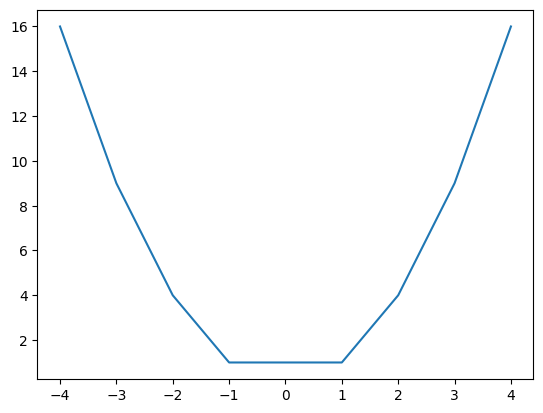Algebra Introduction
This section introduces the basic concepts of algebra, including variables, constants, and functions
Functions
A function is a rule that takes one or more inputs and produces a single output. For example, the function \(f(x) = x + 1\) takes a single input \(x\), adds one to it, and produces a single output. In algebra, functions are written using symbols and formulas. For example, the function \(f(x) = x + 1\) can be written as \(f:x \rightarrow x + 1\). The input to a function is called the argument or input variable. The output is called the value or output variable.
Functions are often written using the following notation:
The notation above is read as “\(y\) equals \(f\) of \(x\)” or “\(y\) is a function of \(x\)”. The notation above is useful because it allows us to define a function without specifying its name. For example, we can define a function \(f\) as follows:
We can then use the function \(f\) to compute the square of any number. For example, \(f(2) = 2^2 = 4\) and \(f(3) = 3^2 = 9\).
Domain and Range of a Function
The domain of a function is the set of all possible inputs to the function. The range of a function is the set of all possible outputs of the function. For example, the function \(f(x) = x^2\) has a domain of all real numbers and a range of all non-negative real numbers. The domain of a function is often written as \(D(f)\) and the range is often written as \(R(f)\).
import seaborn as sb
func = lambda x: x ** 2
x = [-1,-2,-3, -4, 1, 2, 3, 4]
y = [func(i) for i in x]
sb.lineplot(x=x, y=y)
<Axes: >

Piecewise Functions
A piecewise function is a function that is defined by multiple sub-functions, each sub-function applying to a different interval of the main function’s domain. For example, the function \(f(x) = |x|\) is defined by two sub-functions:
Expoents
An exponent is a number that indicates how many times a base number is multiplied by itself. For example, \(2^3\) is the same as \(2 \times 2 \times 2\) and \(2^4\) is the same as \(2 \times 2 \times 2 \times 2\). The number \(2\) is called the base and the number \(3\) is called the exponent. Exponents are often written using the following notation:
The notation above is read as “two to the power of three” or “two cubed”.
Negative Exponents
A negative exponent indicates that the base number should be divided by itself a certain number of times. For example, \(2^{-3}\) is the same as \(\frac{1}{2^3}\) and \(2^{-4}\) is the same as \(\frac{1}{2^4}\). The number \(2\) is called the base and the number \(-3\) is called the exponent. Negative exponents are often written using the following notation:
The notation above is read as “two to the power of negative three” or “two to the power of minus three”.
Fractional Exponents
A fractional exponent indicates that the base number should be multiplied by itself a certain number of times. For example, \(2^{\frac{1}{2}}\) is the same as \(\sqrt{2}\) and \(2^{\frac{1}{3}}\) is the same as \(\sqrt[3]{2}\). The number \(2\) is called the base and the number \(\frac{1}{2}\) is called the exponent. Fractional exponents are often written using the following notation:
The notation above is read as “two to the power of one half” or “two to the power of one over two”.
Logarithms
A logarithm is the inverse of an exponent. For example, the logarithm of \(2^3\) is \(3\). The logarithm of a number \(x\) to the base \(b\) is written as \(\log_b(x)\). For example, \(\log_2(8) = 3\) because \(2^3 = 8\).
Common Logarithms
The common logarithm of a number \(x\) is the logarithm of \(x\) to the base \(10\). The common logarithm of \(x\) is written as \(\log(x)\). For example, \(\log(100) = 2\) because \(10^2 = 100\).
Natural Logarithms
The natural logarithm of a number \(x\) is the logarithm of \(x\) to the base \(e\). The natural logarithm of \(x\) is written as \(\ln(x)\). For example, \(\ln(100) = 4.60517\) because \(e^{4.60517} = 100\).
Polynomials
A polynomial is an expression consisting of variables and coefficients, that involves only the operations of addition, subtraction, multiplication, and non-negative integer exponents.
For example, \(x^2 + 2x + 1\) is a polynomial because it consists of the variables \(x\) and the coefficients \(1\) and \(2\).
The degree of a polynomial is the highest degree of its terms. For example, the polynomial \(x^2 + 2x + 1\) has a degree of \(2\) because its highest degree term is \(x^2\).
Proof by Induction
A proof by induction consists of two cases. The first, the base case, proves the statement for n = 0 without assuming any knowledge of other cases. The second case, the induction step, proves that if the statement holds for any given case n = k, then it must also hold for the next case n = k + 1. These two steps establish that the statement holds for every natural number n.